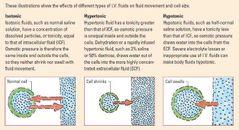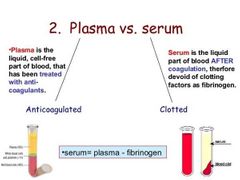![]()
![]()
![]()
Use LEFT and RIGHT arrow keys to navigate between flashcards;
Use UP and DOWN arrow keys to flip the card;
H to show hint;
A reads text to speech;
62 Cards in this Set
- Front
- Back
- 3rd side (hint)
|
Dopram |
Respiratory stimulant. |
Give to puppies sublingually after c section to stimulate breathing. |
|
|
Sympathetic nervous system |
Fight or flight |
|
|
|
Parasympathetic nervous system |
Rest and digest |
|
|
|
Inotrope |
Medication that changes the force of heart contractions. |
|
|
|
Chronotrope |
Medication that alters the hearts rate and rhythm |
|
|
|
1teaspoon = X ml |
5ml |
|
|
|
1 tablespoon= x ml |
15ml |
|
|
|
Clomicalm (clomipramine) |
Treats separtation anxiety, OCD, and depression in dogs. |
|
|
|
1 grain = xmg |
60mg |
|
|
|
Nutraceutical |
Food containing health and medical benefits. |
|
|
|
Bioavailability |
the proportion of a drug or other substance which enters the circulation when introduced into the body and so is able to have an active effect. |
|
|
|
Nonproprietary name |
Generic name of a drug or active ingredient |
|
|
|
Proprietary name |
Brand name |
|
|
|
Therapeutic range |
the dosage range or blood plasma or serum concentration usually expected to achieve the desired therapeutic effect. |
|
|
|
Therapeutic index |
is a quantitative measurement of the relative safety of a drug. It is a comparison of the amount of a therapeutic agent that causes the therapeutic effect to the amount that causes toxicity |
|
|
|
Drug compounding |
often regarded as the process of combining, mixing, or altering ingredients to create a medication tailored to the needs of an individual patient. |
|
|
|
Withdrawl time |
defined as the time required after administration of a drug to a dairy cow needed to assure that drug residues in the marketable milk is below a determined maximum residue limit (MRL). |
|
|
|
Nociocepter |
is a sensory neuron that responds to damaging or potentially damaging stimuli by sending “possible threat” signals to the spinal cord and the brain. |
Pain receptor |
|
|
Digoxin |
helps make the heart beat stronger and with a more regular rhythm. |
|
|
|
Parenteral drugs |
Not by mouth. Usually injectable |
|
|
|
Repository drug |
Designed to act over a prolonged period of time. |
|
|
|
Chloramphenicol |
Antibiotic Avoid in food animals cause aplastic anemia in people |
|
|
|
Orchidectomy |
Neuter |
|
|
|
Onychectomy |
Declaw |
|
|
|
Cystotomy |
Incision into urinary bladder. Usually for removal of bladder stones. |
|
|
|
Urethrostomy |
Process of making an external openingin the urethrain the area of the perineum that is large enough for the passage of urine, mucus, crystals, and small calculi without obstruction. Bypasses penile urethra where obstruction often occurs. Blocked tom cats. |
|
|
|
Mastectomy |
Removal of mammary gland. |
|
|
|
Celiotomy or laprarotomy |
Incision into the abdominal cavity. Includes many elective surgeries such as ovariohysterectomy, organ biopsy, cystotomy, cesarean delivery, gastropexy, cryptorchidectomy. Also includes nonelective surgies such as gastric dilation volvulus, intussusception, foreign bodies, ruptured spleen, diaphragmatic hernia and more. |
|
|
|
Gastrotomy |
Incision into the stomach |
|
|
|
Enterotomy |
Incision into the intestine |
|
|
|
Anesthesia |
Absence of sensation that affects either the whole body or an isolated region of the body. |
|
|
|
General anesthesia |
Unconsciousness and insensibility to feeling and pain induced by administering anesthetic agents. |
|
|
|
Anesthetic induction |
Process used to take patient from a state of consciousness to general anesthesia. |
|
|
|
Anesthetic maintenance |
Process used to keep patient under general anesthesia until recovery |
|
|
|
Local anethesia |
Loss of sensation in a localized body part or region inducef by the administration of a drug or other agent without loss of consciousness. |
|
|
|
Premedication |
Refers to the admisistration of an agent before induction of general anesthesia to calm and relax the patient, ease induction and recovery, minimize adverse effects, reduce the amount of general anesthesic needed, provide muscle relaxation, or pain control.
|
|
|
|
Sedation |
State of calm or drowsiness |
|
|
|
Tranquilization |
State of relaxation and reduction of anxiety. |
Many tranquilizers produce some degree of sedation. |
|
|
Dental abrasion |
Tooth wear from aggressive chewing on external objects. |
|
|
|
Dental attrition |
Wear from tooth to tooth contact |
|
|
|
Class II maloculusion |
Mandible is shorter than maxilla |
|
|
|
Maxillary prognathism |
Abnormally long maxilla |
|
|
|
Mandibular brachygnathism |
Abnormally short mandible |
|
|
|
Class III maloccusion |
Maxilla is shorter than the mandible |
|
|
|
Mandibular prognathism |
Abnormally long mandible |
|
|
|
Maxillary brachygnathism |
Abnormally short maxilla |
|
|
|
Class I Malocclusion |
Occurs when maxillary and mandibular jaw lengths are normal but one or more teeth are in an abnormal position. Most common type to receive orthodontic correction in pets.v |
|
|
|
Wry malocclusion |
Condition where one segment of the jaw is disproportionate to the other segment. Example the left mandible is longer than the right mandible. |
|
|
|
Uncomplicated tooth fracture |
No pulp exposure |
|
|
|
Complicated tooth fracture |
Pulp exposure |
|
|
|
Stomatitis |
Diffuse inflammation of the entire oral cavity |
|
|
|
Gingivitis |
Inflammation of the gingiva |
|
|
|
Emergency tracheostomy |
Procedure of placing a tube inside the trachea from the neck to facilate breathing in the event that the oral cavity is blocked |
|
|
|
Neuroleptanalgesia |
State of profound sedationand analgesia produced by simultaneous administration of an opoid + tranquilizer. |
|
|
|
Cachexia |
Weakness and wasting of the body due to severe chronic illness |
|
|
|
Crystalloid fluids |
Isotonic fluids consisting of mostly water with sodium or glucose. They are used for volume expansion and rapidly redistribute into the extracellular space. |
|
|
|
Isotonic fluid |
Such as cyrstalloids, have fluid and electrolyte content similar to plasma. Concentrations are equal so cells will not shrink or expand but fluid volume will increase. |
|
|
|
Colloid fluids |
Contain high-molecular-weight particles, which remain in the vascular space longer than crystalloids. Examples hetastarch. |
|
|
|
Types of soultions |

|
|
|
|
Plasma vs serum |

|
|
|
|
Chemosis |
Conjunctival edema. Can be associated with overhydration. |
|
|
|
Disseminated Intravascular Coagulation (DIC) |
Systemic clot formation and loss of regulatory control. Symptom: abnominal or gum petechiae. |
|

